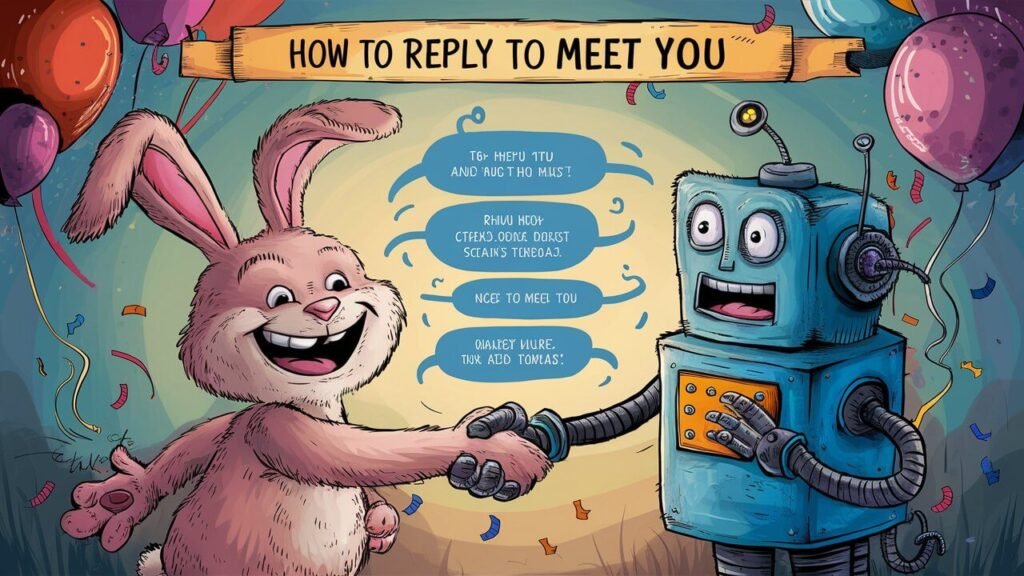
“Nice to meet you too!” Or “It’s a pleasure to meet you as well!”
### Introduction Meeting new people can be a rewarding experience. Knowing how to respond politely and warmly can leave a positive impression. Whether in professional settings or casual encounters, your reply can set the tone for future interactions. A simple yet effective response shows respect and enthusiasm.
It demonstrates your interest in the conversation and the person. Practice these courteous phrases to enhance your communication skills. They can help build better relationships, both personally and professionally. Remember, a friendly and genuine reply can make all the difference. Your words reflect your attitude and approach towards new connections. So, always aim to be kind and approachable.
First Impressions Count
First impressions are vital. They shape how others see you. A polite reply sets a positive tone. It shows respect and warmth. How you respond can impact future interactions.
The Power Of Politeness
Politeness is powerful. It builds bridges and fosters goodwill. A simple, polite reply can make a big difference. Here are some ways to respond politely:
- “Likewise, nice to meet you.”
- “It’s a pleasure to meet you.”
- “The pleasure is mine.”
These responses are short but effective. They show you value the other person. Politeness paves the way for positive interactions.
Setting The Tone For Future Interactions
Your reply sets the tone for future interactions. A warm, friendly response encourages more conversations. It shows you’re open and approachable. Consider these examples:
| Situation | Response |
|---|---|
| Meeting a colleague | “Nice to meet you, looking forward to working together.” |
| Networking event | “Nice to meet you, I hope we can stay in touch.” |
| Social gathering | “Nice to meet you, let’s chat more soon.” |
These responses show enthusiasm and interest. They help build strong connections. Remember, your words matter. Choose them wisely to create positive first impressions.
The Art Of Responding To ‘nice To Meet You’
Meeting new people can be exciting. Responding to “Nice to meet you” with grace makes a great impression. Your response can be verbal or non-verbal. Let’s explore how to master this art.
Verbal Responses With Grace
Words are powerful. Here are some graceful ways to respond:
- “It’s a pleasure to meet you too.” – Simple and polite.
- “Likewise, I’ve heard great things about you.” – Shows interest.
- “The pleasure is all mine.” – Very formal and respectful.
- “I’m delighted to meet you.” – Expresses joy.
Choose words that suit the occasion. Be genuine and sincere. Your tone should match your words.
Non-verbal Cues That Speak Volumes
Non-verbal communication is just as important. Here are some key cues:
| Non-Verbal Cue | Meaning |
|---|---|
| Smile | Shows warmth and friendliness. |
| Firm Handshake | Conveys confidence and respect. |
| Eye Contact | Indicates sincerity and engagement. |
| Nod | Shows agreement and attentiveness. |
Body language enhances your words. A friendly smile paired with a firm handshake creates a lasting impression. Make sure your non-verbal cues are consistent with your words.
Cultural Variations In Greetings
Greetings vary widely across cultures. Different customs and traditions shape these greetings. Understanding these variations is crucial in global interactions. A simple “Nice to meet you” may need a different response in different cultures. This section explores these cultural nuances.
Adapting To Global Etiquette
Adapting to global etiquette involves learning how different cultures greet each other. Some cultures value formality, while others prefer casual greetings. In some countries, a bow is customary. In others, a handshake or a hug is common.
Here is a table showing some common greetings:
| Country | Common Greeting |
|---|---|
| Japan | Bowing |
| France | Cheek Kissing |
| USA | Handshaking |
| India | Namaste |
Understanding Regional Differences
Understanding regional differences can help in responding appropriately. In Asia, people often bow to show respect. In Europe, cheek kissing is common among friends and family. In the Middle East, a light touch or hug may be used.
Here are some tips for replying to “Nice to meet you” in different regions:
- Asia: Bow slightly and say, “Nice to meet you too.”
- Europe: Smile and say, “Nice to meet you as well.”
- USA: Firm handshake and say, “Nice to meet you too.”
- Middle East: Light hug or touch and say, “Nice to meet you.”
These small adjustments can make a big difference. They show respect and understanding of cultural norms.
Professional Settings Versus Casual Encounters
Knowing how to reply to “Nice to meet you” can be crucial. Your response can vary based on the setting. This guide helps you navigate these situations smoothly.
Navigating Workplace Introductions
In a professional setting, a proper reply is essential. Your response should be polite and confident. Here are some examples:
- “It’s a pleasure to meet you too.”
- “Thank you, I’m looking forward to working with you.”
- “The pleasure is mine.”
These responses show respect and professionalism. They also help in building rapport with colleagues or clients.
Ease In Social Situations
Casual encounters often allow for more relaxed replies. You can be more personal and friendly. Here are some suggestions:
- “Nice to meet you too!”
- “Great meeting you!”
- “Likewise, it’s been lovely.”
These responses create a warm and friendly atmosphere. They help in forming personal connections quickly.
The Role Of Body Language
Body language plays a crucial role in communication. It enhances verbal exchanges and helps express emotions. When meeting someone, your body language can make a positive impression. It shows your interest and sincerity.
Eye Contact And Smiles
Eye contact is vital during introductions. It shows confidence and attentiveness. People feel valued when you look them in the eye. Avoiding eye contact can seem rude or disinterested.
A warm smile can make a big difference. Smiling shows friendliness and openness. It makes the interaction pleasant. A genuine smile can create an instant connection.
Handshakes And Gestures
Handshakes are a common greeting gesture. A firm handshake conveys confidence. A weak handshake might seem uninterested. Ensure your handshake is neither too strong nor too soft.
Gestures can add to your communication. Nodding shows you are listening. Open palms indicate honesty. Avoid crossing your arms; it can seem defensive.
Here is a quick table to summarize the key points:
| Body Language Element | Impact |
|---|---|
| Eye Contact | Shows confidence and attentiveness |
| Smiles | Indicates friendliness and openness |
| Handshakes | Conveys confidence |
| Gestures | Enhances communication |
Remember, body language is powerful. It can enhance your words and make your interactions more effective.
When And How To Offer A Follow-up
Meeting someone new can be exciting. But, knowing how to follow up is key. A good follow-up can turn a brief encounter into a lasting connection.
Extending Conversations Naturally
After saying “Nice to meet you,” keep the conversation flowing. Ask open-ended questions. For example, “What brought you here today?” or “What’s your favorite hobby?” This shows interest and keeps the chat lively.
Listen actively to their responses. Share your own experiences. This makes the conversation balanced and engaging.
Exchanging Contact Information
If the conversation goes well, suggest exchanging contact information. You can say, “I’d love to stay in touch. Can I have your email?” or “Let’s connect on LinkedIn.”
Make sure to have your own details ready. A business card works great for formal settings. For informal meetings, a quick exchange of phone numbers works well.
| Setting | Contact Method |
|---|---|
| Formal | Business Card, LinkedIn |
| Informal | Phone Number, Email |
Offering a follow-up can be simple. Just be genuine and considerate. Happy connecting!
Email And Digital Correspondence Etiquette
In today’s digital world, good manners online are very important. This includes how we reply to emails and messages. A polite response can leave a lasting impression. It shows respect and professionalism.
Crafting A Thoughtful Email Reply
Replying to an email with “Nice to meet you” can be tricky. Here are some tips:
- Start with a greeting: Begin with “Hello” or “Hi”.
- Express gratitude: Thank the person for their email.
- Personalize your response: Mention something specific from their message.
- Keep it short: Be concise and to the point.
- End with a polite closing: Use “Best regards” or “Sincerely”.
Here is an example:
Hello [Name],
Thank you for reaching out. It’s great to connect with you.
I appreciate the information you shared about [specific topic].
Best regards,
[Your Name]
Social Media Introductions And Responses
On social media, introductions are often brief. Responding with “Nice to meet you” can be done quickly. Here are some tips:
- Acknowledge the introduction: Use their name if possible.
- Show enthusiasm: Use friendly language.
- Keep it casual: Social media is less formal.
Example response:
Hi [Name],
Nice to meet you! Looking forward to connecting with you here.
Cheers,
[Your Name]
Remember, good etiquette online is key to building strong relationships. Whether through email or social media, a thoughtful reply can make a big difference.
Common Mistakes To Avoid
Meeting someone new can be exciting, but replying to “Nice to meet you” can sometimes be tricky. Many people make mistakes that can make the interaction awkward. Here are some common mistakes to avoid.
Overthinking The Interaction
One of the biggest mistakes is overthinking the response. You may feel the need to say something unique or profound. This can lead to awkward pauses or overly complicated responses. Keep it simple and genuine.
- Avoid long, drawn-out responses.
- Stick to a simple, “Nice to meet you too.”
- Smile and make eye contact.
Overthinking can make you seem nervous or insincere. A relaxed and straightforward reply works best.
Ignoring Cultural Nuances
Different cultures have different ways of greeting and responding. Ignoring these cultural nuances can lead to misunderstandings. For example, in some cultures, a simple nod or bow is more appropriate than a verbal reply.
| Culture | Appropriate Response |
|---|---|
| Western | “Nice to meet you too.” |
| Japanese | A slight bow with a smile. |
| Middle Eastern | A warm handshake and a nod. |
Being aware of cultural differences shows respect. It also helps you make a good impression.
Practicing And Improving Your Approach
Replying “Nice to meet you” can be more engaging. Practicing can help make your responses better. Improving your approach will make you sound more genuine. Here are some tips to help you practice.
Role-playing Scenarios
Practice makes perfect. Role-playing scenarios can help you get better. Find a friend or family member to practice with. Here are some scenarios:
- Meeting a new colleague: Imagine you meet a new coworker. Practice saying, “Nice to meet you. I look forward to working with you.”
- Networking event: Pretend you are at a networking event. Say, “Nice to meet you. I enjoyed learning about your work.”
- Social gathering: Act like you are at a party. Reply with, “Nice to meet you. I hope we can chat more.”
Learning From Past Experiences
Think about past experiences. How did you reply before? Make a list of what worked well and what did not. Here are some steps to learn from your past:
- Reflect: Take a moment to think about past interactions.
- Analyze: Write down what you said and the other person’s reaction.
- Adjust: Make changes based on your analysis.
This helps you improve your responses over time. Keep practicing and you will get better.
Conclusion: The Lasting Impact Of A Kind Reply
The way you reply when someone says “Nice to meet you” holds significant power. Your response can create a lasting impression and set the tone for future interactions. This moment offers an opportunity to be memorable, kind, and engaging.
Summarizing Key Takeaways
Here are the key points to remember:
- Always express gratitude for the introduction.
- Personalize your response to show genuine interest.
- Maintain eye contact and smile to convey warmth.
- Follow up if appropriate, to build a stronger connection.
These actions can enhance your social and professional relationships.
Encouraging Positive Meeting Outcomes
A kind reply encourages positive outcomes in future meetings. Here are some benefits:
- Builds trust: People are more likely to trust kind individuals.
- Enhances rapport: A good reply can improve mutual understanding.
- Open doors: Kindness can lead to new opportunities and collaborations.
Investing in a kind reply can have long-term benefits. It helps in creating strong, positive relationships.
Frequently Asked Questions
What Should I Reply To Nice To Meet You?
“Nice to meet you too!” Or “Pleasure meeting you as well!”
What Do You Say Next After Nice To Meet You?
You can say, “How are you? ” Or “What brings you here? ” These questions keep the conversation going.
What To Reply When Someone Says Good To See You?
Reply with a smile and say, “Good to see you too!” You can also add, “How have you been? “
How To Reply Nice To Connect With You?
Thank you! It’s great to connect with you as well. Looking forward to collaborating!
Conclusion
Mastering the art of replying to “Nice to meet you” can enhance your social interactions. Use these tips to leave a positive impression. Remember, a genuine response can build stronger connections. Practice these phrases to boost your confidence and make every meeting memorable.

